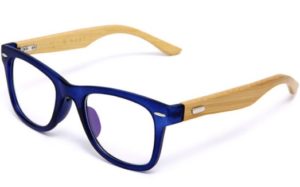When choosing glasses, not only a comfortable frame is of great importance, but also good, high-quality lenses with the right coating, which has a positive effect on eye health.
What kind of coatings are there?
There are several types:
 enlightening. Increases transparency, eliminates glare, reduces strain on the eye muscles. Indispensable for computer and driving glasses;
enlightening. Increases transparency, eliminates glare, reduces strain on the eye muscles. Indispensable for computer and driving glasses;- blocking ultraviolet rays. Prevents retinal damage;
- strengthening. It is applied to both sides of plastic glasses, protecting them from damage and increasing their service life;
- hydrophobic. Provides a perfectly flat surface, preventing drops of liquid from drying on it;
- antistatic. Repels dust particles, making product care easier;
- photochromic. Depending on the brightness of the light, it changes the color of the products from transparent to darkened, while maintaining ideal light transmittance;
- mirror Significantly reduces the access of light to the eyes. Not recommended for cloudy weather and driving in the evening;
- colored (cosmetic). It is applied for the purpose of decoration, partial or significant suppression of the brightness of external light sources. Depending on the color, it produces various effects: from anti-reflective to anti-stress;
- multifunctional. Combines several types of coatings that improve the final result.
What are the benefits of Japanese lenses?
Japan is one of the largest manufacturers of spectacle glasses on the world market. The products of ophthalmological companies in the Land of the Rising Sun are made from high-quality materials, fits perfectly aesthetically into any frame - even the thinnest and lightest. There are ready-made models on the market, and custom-made ones are available, including using the latest 3D technologies.
Disadvantages of such lenses
Their average service life is only 2–3 years, since they are made mainly from polymer materials. Combined with the high price, this can be considered a disadvantage. Some photochromic models are difficult to clean.
What brands are there?
There are several Japanese corporations that have established themselves in the optics market.
Hoya
 Leader among Japanese optical companies. For more than 60 years it has been producing products of the highest quality, constantly expanding production. Its range includes models for the correction of almost all visual impairments. The company carries out and controls the entire process, from the development of materials, design of models, patenting of its own manufacturing and coating technologies, and ending with the release of finished products.
Leader among Japanese optical companies. For more than 60 years it has been producing products of the highest quality, constantly expanding production. Its range includes models for the correction of almost all visual impairments. The company carries out and controls the entire process, from the development of materials, design of models, patenting of its own manufacturing and coating technologies, and ending with the release of finished products.
Seiko
A well-known manufacturer of high-tech products for individual vision correction. Specializes in production branded progressive lenses with premium coatings. The first in the world to produce ultra-thin photochromic models made of organic material.
Tokai
 The third largest manufacturer of spectacle lenses in Japan, which are manufactured only in domestic factories. It has existed since 1939, constantly introducing innovative materials and technologies. Exports products to the USA, Europe and Asia. It is especially in demand corrective lenses for sports glasses with a large radius of curvature and multifunctional coating.
The third largest manufacturer of spectacle lenses in Japan, which are manufactured only in domestic factories. It has existed since 1939, constantly introducing innovative materials and technologies. Exports products to the USA, Europe and Asia. It is especially in demand corrective lenses for sports glasses with a large radius of curvature and multifunctional coating.
Nikon
The corporation has gone through a hundred-year development path, starting it as a manufacturer of optical glass. She created the first spectacle glasses in 1946, and by 1950 she began producing them on an industrial scale. To date, her aspherical lenses made from a material with a high refractive index have excellent optical performance.
You can purchase spectacle lenses in optical stores, sales offices of manufacturers, and in online stores. By choosing them correctly, you can not only preserve your vision or neutralize the consequences of a number of ophthalmological diseases, but also complement your image with a stylish and useful accessory.



 0
0





